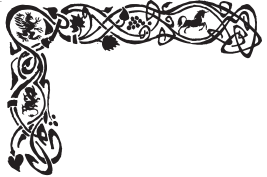The Big Pretence
The world according to Apple & Co was built for the human race, like about 5 minutes ago. Forget all that “billion year old carbon” bullshit. They will shape the world to what they see as human needs. Unfortunately, we share the planet with a zillion other species, and the needs of humans as defined by Apple & Co run counter to this other world. This is almost like one of those alternate futures you find in comic books; one is human-centric, the other is planetary and cosmic. One timeline leads to maybe an AI-verse (the big zilch); the other to
GENERATION
There is something deadly serious about Apple. Whereas old-time musicals (and DD) have meta-content which is very meaningful, along with a light-hearted style of performance, Apple has this idea of style that is almost no style.
I suppose you’re wondering why compare a technology company to that good old-time singing & dancing? The reason is that there is an existential question of content. Musicals have some introspection in their old time settings and sense of history, and the style to pull it off. Style (performance) and content (introspection).
At the core of Apple is a lack of content. That’s all very nice and smooth, but content is the inner mind, the imagination, unconscious imagery, urges. The inner life is the psychological life (Greek drama, Elektra Assassin). You might say it’s just a tech-company, it’s also the biggest that represents that view of the future.
Of course, they’ll call us filthy rebels but you have to ask why should you necessarily like the things they like? The REH Foundation are fairly happy in their mini-ecosystem. I know they call Apple an ecosystem but it for sure isn’t symbiotic. Apple’s system is all sweetness and light whereas an ecosystem proper is light and shade in equal proportions. To be meaningful there must be both – Apollo and Dionysus – so there again is an existential question.
You find this again and again in the epic tradition, where there is a palpable sense of destiny. Since I’ve mentioned Daredevil, did Colan draw all that gloom just for kicks? Even more so for Miller, the Elektra Saga is overtly psychological, a psycho-drama he calls it. It’s gritty and wretched, but there is also a fantastic sense of rhythmic exuberance dancing across the rooftops. Comics have that ability to bring an inner drama to life; the buildings, the architecture in shadow and gloom are meta-imagery.
What you could call monumental narratives are full of this sort of thing. Corto Maltese by Italian Hugo Pratt is a particularly Howard-like character (“The Golden House of Samarkand”). Gloomy and taciturn, the exotic sailor delves into the mystical and the basely material on the fringes of civilization, in the early years of the 20th century. There is a sense of dark gaiety in the tales of Man and boat and seagulls and tribes and ramshackle colonial outposts in Dutch Guiana (Suriname), North Africa etc.

Under the sign of Capricorn, c 1970
DANS LE PORT D’AMSTERDAM
Pratt was influenced by Milton Caniff (Terry and the Pirates), and you could say they are all tales of a much less political time when Man and the meta-imagery that surrounded him were an eco-culture of sorts. Basically, throwing aside the political aspect, what you’re left with is the introspective adventurer. The same types of yarn as were told by the 30s Junto and their peers.

Under the Sign of Capricorn, c 1970
Steiner has here stumbled on evidence of the truth of REH’s Hyborian Age, and that relics may still exist. In Conan, the adaptation of REH’s The Lost Valley of Iskander had the ancient Greeks voyaging through the mists 50,000 years back in time to Hyboria. Steiner seems to think such phenomena are within the realms of science. Could Hyborians have voyaged in the other direction is the question. See note on David Freiberg (Outtake 1)
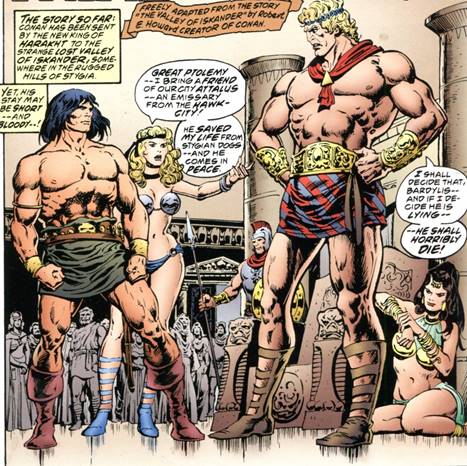
Conan #81, c Marvel 1977
If you can say that an introspective mind reflects the meta-imagery that surrounds Man, then it becomes clear that there are two very different futures. These tales that can seem dark are also infused by a gaiety that comics are very good at conveying; in the rhythms and juxtapositions of panels.
The adventurer is not deadly serious, there is a playfulness to the tone in imagery and black comedy. There is a type of truth to their quest because there is no real aim in mind; their destiny is in the hands of the fates.
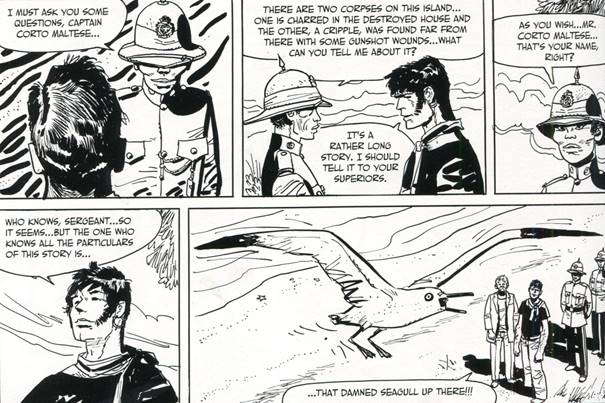 Under the Sign of Capricorn, c 1970
Under the Sign of Capricorn, c 1970Sounds like a cliché? Well, clichés are truths. You find them all over comics. Superhero comics deal in introspective truth; visions, dreams, the urge to rebel. The outer form of this world takes the shape of myth – as with Wonder Woman, say - so you might say the inner mind reflects the outer cosmos. This is quite an ancient idea and, as with Tarot cards, it ties the destiny of someone or a character to the stars, the place of their birth.
If you take Diana Prince, her fate as Wonder Woman is tied-up with her heritage as an Amazon. Her role is to assert the equal ability of women and defeat injustice through the powers given her by six Greek deities on Paradise Island. Her lasso of truth shatters illusions and has a number of wondrous properties.
On the one hand these myths are completely unreal; on the other they are ideal. Diana has both wisdom and perfect physique and strength. The classical ideal is for a balance between mind and body to reveal an unspoken grace of movement. Every Greek black-figure vase was hand-drawn by some anonymous artisan, learning by years of apprenticeship until they were sufficiently versed to free the power of expression. Greek art has both the idealism of anatomy, and pure expression. It's basically a mixture of science and art just as the Renaissance was.
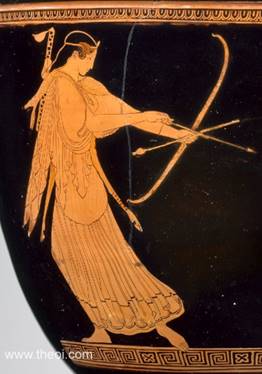
Figure vase of Artemis
This is something comics at their best do well, because it is a quality of line. Anatomy is expressive anatomy, as with Liefeld. This is actually a difficult thing to get across because you might think anatomy is just something learnt, but no. Greek art may have eloquent proportions and idealistic form, but it is also a quality of line, a moment in time. It's basically what you call style.
The closest comparison I can think of is Bruce Lee’s style of fighting, Jeet Kune Do. There are no preset routines or trained responses; there is only an instantaneous reaction. His book Art of Living goes into this at almost obsessive length, and his dislike of formula that becomes the style is self-evident. There has to be a pure expression that has no thought attached to it.
He also coins the phrase, “A war between a robot and a wild animal”; in Jeet Kune Do you have to be both. The basic point is, if you can have pure expression then the training will kick-in, but you have to forget it. He is so incisive on this point because fighting is just a simple physical act, it’s not a series of instructions. Man is able to train himself, which I suppose wild animals aren’t, but the speed and ferocity of a fight is a savage attribute.

Grace Slick cover to Manhole with credit to Bruce Lee
Style or grace isn't a formula or a routine or something learnt. It's a balance between wild ferocity and the anatomical structure. There is a Dionysian aspect; lack of planning, lack of training or, as Nietzsche might say, an urge or desire. This is the ideal or heroic, and there is a sense that the force and dynamism you see in anatomical figures are a quality of that balance, a quality of line.
Take another character, DC’s heroine Wonder Woman. The Amazon’s lasso of truth will shatter illusions with a graceful whirl. The truth is in the action, the flow of the panels. The style. A world where there is no action or flow is a type of lie because you are told everything is a formula. This is the Apple ecosystem.
Sorry to upset the apple-cart but there is a lot more to ecosystems than that! There is an expressive side, true, but also a destructive side, Artemis, the moon. Life is a cyclical process. Destruction is part of a mythos just as it is part of a life-cycle.
Typical Renaissance scene, the myth of the moon goddess Diana, the huntress
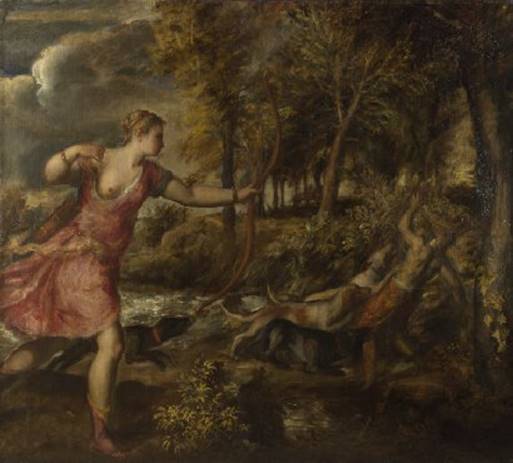
Titian, The Death of Actaeon
Well, not typical since Titian is the greatest! The almost abstract nonchalance of the woodland scene speaks for itself. Actaeon has been metamorphosed into a stag and Diana, the huntress, has set the hounds on him.
The action of a hunt, the baying of bloodhounds, the shrieks of Actaeon as the teeth tear and rend. The brutality of myth has a type of truth. As with Daphne, who became a laurel tree, and joined in the regenerative cycle of death and rebirth.
Myths are meta-imagery that go beyond fact, as with Dali’s Metamorphosis of Narcissus (Outtake 4). They make you see that things change into other things or, as with Dali’s painting, that something that seems inert and moribund has been changed by a psychosis.
The change or metamorphosis or catastrophe is always in the pipeline because it is psychological, felt not factual (Greek tragedy).
PRIDE OF MAN
This idea of life-cycle contained in Renaissance painting is what is lacking in the formulaic Apple ecosystem. So there are really two alternate futures. One is almost all facts; the other almost does without facts! One has very little ambiance; one is all ambiance. One, you could say, is like a cathedral, the other is the new Cupertino mothership – “fat and round”
SHE HAS FUNNY CARS
Home
